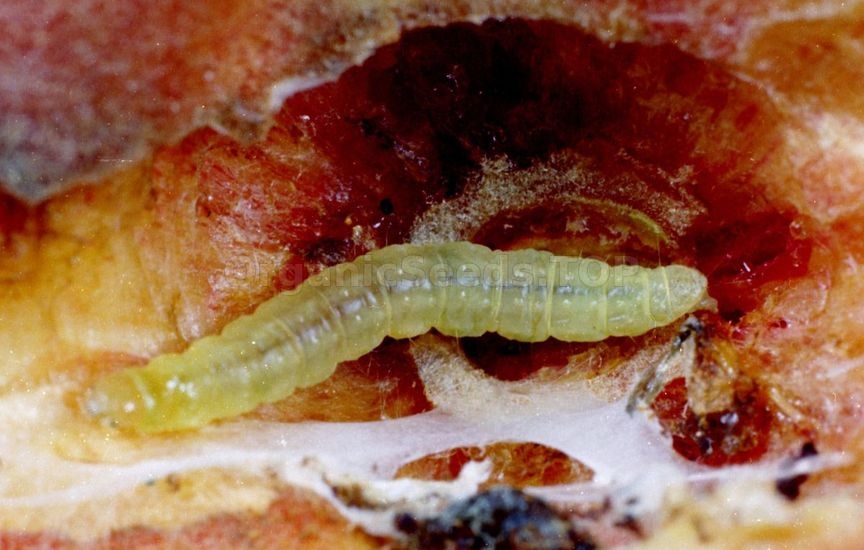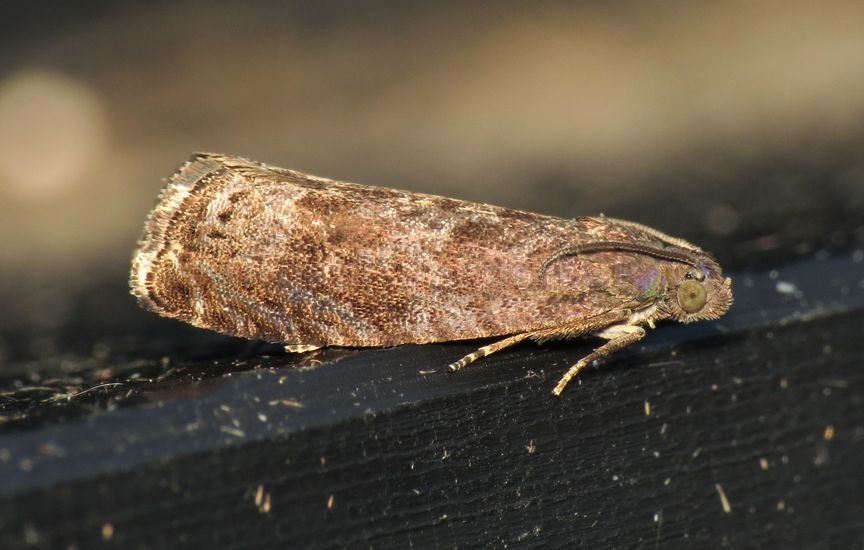Oriental fruit moth - «Grapholita molesta» |
 The oriental fruit moth - is a dangerous pest that damages the fruits and shoots of many fruit crops. Among forage plants it prefers peach, pear and quince. In areas of distribution it can destroy from 50 to 100% of the crop. Reproduction is bisexual. The transformation is complete. Winter conditions are tolerated by caterpillars in cocoons that have reached an advanced age. During the year, 5-6 generations of the pest develop in southern gardens. During the growing season, all stages of insect development can be observed simultaneously. Synonyms: Cydia molesta Busck., Laspeyresia molesta Busck. MorphologyImago
A small butterfly with wide, almost rectangular wings, the rear and outer edges of which form an angle. At rest, the wings are arranged like a roof along the back. The bodies of butterflies are dark gray. The forewings are covered with gray-white scales, which form inconspicuous transverse wavy stripes along the anterior edge of the wing. The location of light spots on the surface of the wings and the shape of these spots are different. The hind wings are grayish-brown with a wide costal margin and grayish-white fringe. On the underside, both the front and hind wings are silver-gray. The wingspan reaches 12-14 mm.  The legs of the insect are dark brown, the inside is silvery. The paws are black and gray with narrow creamy white rings. The antennae are thread-like with thin, indistinct white rings. The length of the antennae reaches half the length of the fore wings. Labial palps are light brown in color. The abdomen is gray, silvery, and has a brown tint. Sexual dimorphism The female is slightly larger. The female's abdomen is thickened and ends with a mirror, while the male's is pointed and narrow. On the hind wing of the male, some scales are fringed with apexes without denticles. In the female genitalia, the copulatory opening is located in the middle of the sclerotized plates. Egg The shape is round. The color is transparent, with a pearlescent tint. Diameter - 0.4 mm. The upper side has small wrinkles. As the egg matures, it turns pink, and 15-48 hours before rebirth, a caterpillar can be seen under the chorion. Larva Immediately after rebirth, the caterpillar has a milky white, cream or pale pink color, a black head, a dark (to black) chest shield, and a brown anal shield. The body of an adult caterpillar has large brownish-gray scutes. Spiracles with dark border. The entire body is covered with small cuticular spines. Between the first and second bristles, under a microscope, two areas are clearly visible in which there are no sculptural formations. The prothoracic shield is brownish-brown in color. The scutellum of the anal segment is yellowish-brown, under it there is a ridge with brown teeth. The number of teeth is from 4 to 7. On the second segment of the chest, the setae are located on one shield. The length of the caterpillar at the last instar is 12-13 mm. Pupa The color of the cover is brown. There are two rows of spines on the dorsal side of the abdominal segments. The eyes are black and have a complex structure. The end of the abdomen has 10-18 sharp spines of various sizes. The length of the pupa itself is 6-8 mm, it is placed in a transparent oval cocoon, colored from light to dark gray. Cocoons of summer generations are denser than winter ones. The length of the cocoon is from 10 to 12.5 mm.  DevelopmentImago
Butterflies fly out of overwintered cocoons in the spring, when the average daily temperature reaches +15°C. They are most active in cloudy and twilight weather. They are reborn in the spring during the flowering of stone fruits. Mating period 3-5 days after birth, females lay eggs. Oviposition lasts from 7 to 14 days. Fertility - up to 200 eggs. A decrease in temperature increases the length of this period. Overwintered females lay eggs on the underside of the leaf blade of young shoots of cherries, peach, plums, almonds, and cherries, as well as on the upper side of apple and quince leaves. Females of summer generations lay eggs in fruits in the area of the stalk and on sepals near the calyx. The duration of oviposition and summer lasts more than a month. Egg Embryonic development lasts from 3 to 15 days. Larva The first generation caterpillars are reborn and, through the apical bud, penetrate into young shoots, gnawing 6-11 cm long passages in them down to the beginning of lignified tissues. Damaged shoots dry out. The next generations of caterpillars feed in the fruits. Cavities are gnawed out of their flesh and filled with excrement. The oriental fruit moth rarely damages seeds. The caterpillars feed for 9-24 days. In stone fruits, development occurs faster. Pupa Pupation takes place in various secluded places: inside damaged shoots, under rolled leaves, on the surface of fruits. The pupal stage can last from 5 to 12 days. The last generation in the growing season cocoons in wintering areas. This can be loose bark on skeletal branches and trunks, cracks in the trunk, dry leaves on the soil surface, places damaged by trees, mummified fruits. The caterpillar overwinters in a dense cocoon.  Abiotic factorsThe complete development cycle from egg to adult lasts from 24 to 30 days. During the season, all phases of development can be observed.
The oriental fruit moth damages young shoots and fruits. Severe damage to shoots causes a lack of green mass growth. Damaged fruits are completely destroyed and become unusable. In European countries, the oriental codling moth damages up to 90% of peach shoots and fruits and up to 50% of pears. Plums, apple trees, medlars, and apricots suffer much less.
You may need:«Oriental fruit moth» trapPheromone trapsGlue trap (single adhesive cardboard) 205x125 mm |
|
|
